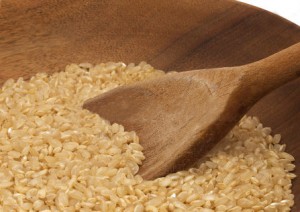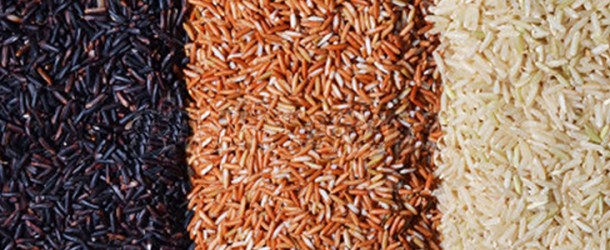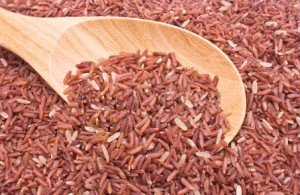Ever since my husband and I switched to brown rice at home, we’ve been repeatedly asked why we think that brown rice is so much better than white rice. I knew on a higher level that brown rice, which is less processed, is better than white rice, but I never had an easy way to answer that question. I usually came up with, “Brown rice is more natural, and not processed,” and “Brown rice has more fiber”.
But I wanted to have a better, more meaningful answer that is more convincing and one which helps people not only understand why brown rice is better but also an answer that would convince even the skeptics to switch to brown rice.
So, let’s get down to basics: Brown rice IS white rice; only white rice is processed; So much so that the USDA (U.S. Department of Agriculture) requires white rice to be fortified with vitamins: thiamine, riboflavin, niacin, Vitamin B6, iron and folic acid. The bran is removed from brown rice and white rice is usually parboiled or precooked. Most people like white rice because it has no real flavor of its own and it is able to take on the flavors of anything that it is paired with. White rice also cooks faster.
Brown rice is rice with only the husk removed. Everything else is kept intact, including the bran (containing fiber), and nutrients, i.e. manganese, magnesium, zinc and Vitamin E.
 There are some drawbacks to all natural brown rice:
There are some drawbacks to all natural brown rice:
- Its shelf life is only ~6 months. After learning this fact, I realized why I could never find a 20lb bag of brown rice, but I could very easily find a 20lb bag of white rice.
- Brown rice has a nut-like flavor, which may not go with everything.
- Brown rice is chewier than white rice and take a little more effort to eat.
- Brown rice takes longer to cook than white rice. You may notice that you need to add more water to the cooker and give brown rice more time to cook.
Some white rice advocates say that brown rice has arsenic in it. This is a known fact; that all rice, brown or white has arsenic in it. Brown rice has ~160 parts per billion inorganic arsenic per serving and infant rice cereal has 120 parts per billion per serving. Rice wine has the lowest level of arsenic, 11parts per billion per serving. These numbers are what the FDA released in 2013 according the article in USA Today, “FDA tests find very low levels of arsenic in rice”, September 6, 2013. But don’t let arsenic in rice scare you away from eating rice all together. Even drinking water has arsenic in it and the EPA has a restriction on drinking water to 10 parts per billion of arsenic per serving. But remember, we drink water many times a day.
Over the years there has been more and more research done on rice, since an article in the British Medical Journal titled, “White rice consumption and risk of type 2 diabetes: meta-analysis and systematic review”(BMJ 2012;344:e1454) found that, “Higher consumption of white rice is associated with a significantly increased risk of type 2 diabetes, especially in Asian (Chinese and Japanese) populations”.
This same finding was echoed by a study done from the Harvard School of Public Health, which showed that white rice has a higher glycemic index than brown rice. Your glycemic index or GI is a measure of how quickly your body converts carbohydrates to glucose and raises blood glucose levels, and ranges from 0-100. The higher the glycemic index, the more easily digested the food is and the more easily it is absorbed by the body, increasing blood glucose levels. Therefore, carbohydrates with low glycemic indices carry a lower risk of diabetes type 2. Fiber also helps to lower the glycemic index. Remember that brown rice has bran, which contains a high dose of fiber. Fiber slows down the speed at which carbohydrates are converted into sugars, thereby lowering the glycemic index.
Now, as an Asian Indian rice consumer myself, I know that there are more than one type of rice. In fact, there are 235 types of rice around the world. And each has its very own glycemic index. The GI of rice varies from a low of 48 to a high of 92! There is a non-profit International Rice Research Institute, believe it or not. They were founded on December 9, 1959 by the Ford Foundation and the Rockerfeller Foundation and they are headquartered in Los Banos, Laguna (Philippines). Recently this Institute identified a gene called the “waxy gene”, which is a gene that determines the glycemic index of rice. This was published in the Journal “Rice” in June 2011, Vol.4, Issue.2,pp.66-74. Research into the glycemic index of carbohydrates will dramatically affect what types of rice we consume.
If you have diabetes and are on a stricter diet you need to be aware of what type of rice you are consuming and know its glycemic index. Carbohydrates with a lower glycemic index are always better for you.
Remember that long grain rice has a lower glycemic index than short grain rice; and brown rice has a lower glycemic index than white rice. Remember that brown rice is more natural and has many more natural nutrients as well as bran which white rice does not have. White rice has nutrients as well, however these nutrients are fortified, or artificially added to the rice before they get to us, the consumer. White rice also has a high glycemic index.
So, the next time someone asks me why I eat brown rice now and not white rice, I’ll be able to teach them a thing or two and maybe even convince them to switch over, like we did. Why not eat what nature intended!


Thanks for your detailed post and I agree that people watching their sugar intake should eat brown rice. I used to eat only brown rice but switched back to white because I found it easier on my stomach. The bran is harder to digest and I was trying to eat a lot of carbs while marathon training last year. My runs after eating white rice were much better than runs after eating brown rice or wheat for dinner. So I think that if you are a healthy person not watching your carb intake and already eating a lot of fiber, then white rice is fine.
I heard that white whole wheat flour is a healthier alternative for all-purpose flour. It has a similar taste, texture and flavor to that of all-purpose flour. Is there such a thing in the rice world; is there a healthier type of rice that is similar to white rice?